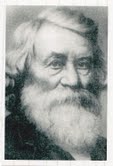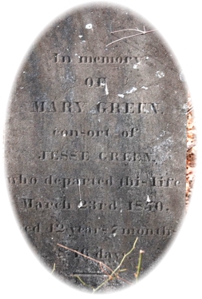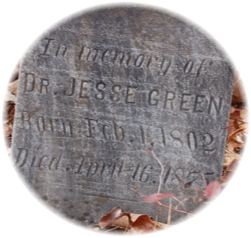 Jesse Lovask Green was born on February 1, 1802 to parents Amos and Elizabeth (Searcy) Green in Rutherford County, North Carolina. Amos and Elizabeth were the parents of several children, possibly as many as twelve or thirteen. In 1810 there were eight household members enumerated in Amos Green’s household and in 1820 there were thirteen.
Jesse Lovask Green was born on February 1, 1802 to parents Amos and Elizabeth (Searcy) Green in Rutherford County, North Carolina. Amos and Elizabeth were the parents of several children, possibly as many as twelve or thirteen. In 1810 there were eight household members enumerated in Amos Green’s household and in 1820 there were thirteen.
Although no slaves had been enumerated in the two previous censuses, in 1830 the Amos Green family possessed three slaves – two females between 10 and 23 and one male under 10. However, by that time Jesse and his wife Mary Ann had migrated to Cherokee County, Georgia, arriving there in 1824. There Jesse purchased land along the Etowah River and settled among the Cherokee Indians.
The area where Jesse and Mary Green settled was home to several tribes at various times in history and place names in that region reflect that culture. However, by the end of the 1830’s Cherokee Indians were expelled from their native lands and removed to Indian Territory, later to be called Oklahoma. According to the Georgia Encyclopedia, the removal “was a product of the demand for arable land during the rampant growth of cotton agriculture in the Southeast, the discovery of gold on Cherokee land, and the racial prejudice that many white southerners harbored toward American Indians.”
 It’s presumed that Jesse had a friendly relationship with his Cherokee neighbors, since according to family historians he used herbs and remedies imparted to him by the Indians. Some family researchers believe, although they have no solid proof, that Jesse may have been married first to an Indian woman, presumably in North Carolina before he migrated to Georgia. While Jesse was enumerated in 1850 and 1860 as a “physician” it is unclear whether he had received conventional medical training or had merely observed the practices of his Cherokee neighbors.
It’s presumed that Jesse had a friendly relationship with his Cherokee neighbors, since according to family historians he used herbs and remedies imparted to him by the Indians. Some family researchers believe, although they have no solid proof, that Jesse may have been married first to an Indian woman, presumably in North Carolina before he migrated to Georgia. While Jesse was enumerated in 1850 and 1860 as a “physician” it is unclear whether he had received conventional medical training or had merely observed the practices of his Cherokee neighbors.
Jesse and Mary Green are believed to have had eleven or twelve children before Mary passed away on March 23, 1850 in Ball Ground, Cherokee, Georgia. The 1850 census, recorded five months following Mary’s death, indicates that Jesse was a widower with nine children living in his home: Lewis (25); Louisa (18); Lucinda (16); William (13); Juliann (11); Mary Ann (9); Joseph Hanson (7); Jasper (5); and Elizabeth (3). Their daughter Sarah (b. 1827) had married Edward Bagby in 1848.
Following Mary’s death, Jesse married Louisa Johnston in 1851 and she bore him several more children: Sophronia (1852); Emeline (1853); Henry (1855); Margaret (1856); Louvenia (1858); Virgil (1860); Jesse (1863); Lisena (1864); Martha Ellen (1865); Amanda (1869) and Delia (1875). There may have been a contagious illness in the family, years after Jesse’s death, when Delia and Virgil both died in May of 1889.
In fact, Jesse died on April 16, 1875 just a few months before Delia was born on July 1, and he was buried in the same cemetery as Mary Ann, and later, several of his children. Louisa was enumerated in 1880 as a widow and the head of her household. In 1900 she was living with her son Jesse B. Green and his family before they moved to Grayson County, Texas between 1900 and 1910. Louisa died there on September 3, 1905 and is buried in the Christian Chapel Cemetery. Inscribed on her tombstone she is noted as the wife of Dr. Jesse Green, late of Georgia.
While researching Jesse Green and his family, I stumbled on a bit of history which provides insight on how the less fortunate, especially mentally handicapped individuals, were regarded by some in those days. Amos and Elizabeth Green had migrated to Cherokee County between 1830 and 1840. In 1850, two individuals, presumably two of their children, were residing in the same household: Oliver P. (30) and Nancy (27).
Oliver and Nancy apparently had a mental handicap as they were both noted in column 13 of the census form as “idiot”. When Nancy died is unclear, however, because there doesn’t appear that a date was ever inscribed on her tombstone – merely the notation “IDIOT”. How sad is that?
 The 1850 census was the first one that all members of the household were enumerated separately and the census taker was required to inquire as to the full health of each occupant. In 1850 the choices in column 13 of the form were “dumb”, “blind” or “idiotic” (left blank if “normal” it appears).
The 1850 census was the first one that all members of the household were enumerated separately and the census taker was required to inquire as to the full health of each occupant. In 1850 the choices in column 13 of the form were “dumb”, “blind” or “idiotic” (left blank if “normal” it appears).
In 1860 and 1870 the questions were the same, but in 1880 there were separate schedules for: Insane (Schedule 2); Idiots (Schedule 3); Deaf-Mutes (Schedule 4); Blind (Schedule 5); Homeless Children (Schedule 6); Prisoners (Schedule 7); and Pauper and Indigent (Schedule 7a).
If, for instance, a person was enumerated in 1880 as an “idiot”, you can find additional information about them on Defective Schedule 3. For “idiot”, information such as date of onset, supposed cause and size of head is provided. Interesting, huh?
 Did you enjoy this article? Yes? Check out Digging History Magazine. Since January 2018 new articles are published in a digital magazine (PDF) available by individual issue purchase or subscription (with three options). Most issues run between 70-85 pages, filled with articles of interest to history-lovers and genealogists — it’s all history, right? 🙂 No ads — just carefully-researched, well-written stories, complete with footnotes and sources.
Did you enjoy this article? Yes? Check out Digging History Magazine. Since January 2018 new articles are published in a digital magazine (PDF) available by individual issue purchase or subscription (with three options). Most issues run between 70-85 pages, filled with articles of interest to history-lovers and genealogists — it’s all history, right? 🙂 No ads — just carefully-researched, well-written stories, complete with footnotes and sources.
Want to know more or try out a free issue? You can download either (or both) of the January-February 2019 and March-April 2019 issues here: https://digging-history.com/free-samples/
Thanks for stopping by!


Dr. Jesse Green was my ggggrandfather. Your research is good. Thanks. BuT–where did you uncover the name Lovask?
I have many copies of his deeds and none of these documents have even an initial L on them…. all are signed simply Jesse Green.
I have researched to find if and when Dr. Jesse studied through a college of medicine — Medical College of Ga. was not started until 1828, checked Medical College of Charleston. Finally found other information that most “physicians” studied as apprentice with others to learn to be physicians, or healers. This practice continued well into the 1900s.
The family story was Mary Ann Ward Green, Jesse’s wife died of “heart dropsy” and he had worked on and concocted a “cure for heart dropsy”. Never found this documented although I found through the Atlanta History Association they did not have Jesse but here is what they had.
“According to the Atlanta City Directories, H. H. Green, physician ( specialty dropsy) first appeared in the 1882 directory, residing at 37 Larkin and residing at 55 Jones Ave. in 1885. In 1891 Dr. H.H. Green and Sons (Henry H., Alfred F., Elijah W. and John W. ) dropsy specialists, worked out of office at 30 Marietta St. and Henry H. lived in Kirkwood, Georgia.”
I have not pursued this as I have such a voluminous amount of Green information — much, much of which from the internet is plain wrong—– to verify and write about.
Never heard Dr. Jesse was married prior to marriage to Mary Ann Ward as he would have been 21 when he married Mary Ann.
Thank you .
E. Ruth Green, Ph.D.
I just stumbled across the family cemetery last weekend by accident because I am going to be building a house in the subdivision where the cemetery is located. I just happened to notice what appeared to be a headstone on top of the hill and walked up to investigate. I’m wondering who owns this property now. It would be nice if this cemetery could be preserved, and if someone could put a wrought iron fence around it out of respect for those who are buried there. So sad to see this graveyard abandoned and not taken care of. I’m sure there are many more like this across the nation.
It is so sad these abandoned cemeteries aren’t kept up, or that some people take the headstones away. Maybe you could start a campaign to spruce up the cemetery and put up a simple fence. Genealogists would be especially appreciative I’m sure. In fact, you might want to check with a local genealogical society to see if they might be able to assist. Good luck and thanks for stopping by!
You can report to historical society. They can tell you what can be done to preserve this cemetery.
Actually we cleaned up the Amos Green cemetery, located in the subdivision, years ago, about 2000. It is not abandoned, but just very old. Hard to clear everything without risking damage to the headstones. And the boundaries are uncertain, since there appears to be several Native American and African American graves on the perimeter. It has been registered with the county for many years.
The people that own the property did live in the old gone with the wind house across the road. That was dr jesse green plantation..he is my great great grandfather. His second wife louisa johnston. Their daughter martha ellen married Riley Rich had a daughter Susie Virginia Rich married luther sims my grandmother and grandfather. I wish they would preserve that cemetery it is sad to know they are grown up.I would have.like to stroll over it but my health want permit.me jenny meadows sauls on FB.
Jesse Green was my gggrandfather- by a second wife, Louisa Johnston. According to the dates she was 30 years younger than he. Apparently he was the father of 18 kids by these wives. I am very interested in learning more about the Green family. My email is [email protected]
Joan, thanks for stopping by! The Jesse Green article has been snipped because it will eventually be featured in an issue of Digging History Magazine, the digital version of the original Digging History blog where you landed. I don’t know exactly when it will appear in the magazine; however, if you’d like to sign up to follow the magazine blog you will receive notifications of monthly issues, as well as occasional blog posts on various topics. Each month’s issue is packed with articles focused on history and genealogy (Digging History also provides genealogical research services and designs custom pedigree charts), including tips and what I like to call “adventures in research”.
Go to the magazine site: wwww.digginghistorymag.com and scroll to the bottom of any page to subscribe by providing your email. Just for signing up you’ll receive a free issue of the magazine to enjoy. — Sharon Hall, Publisher and Editor, Digging History Magazine
interesting! McCraws married into my Word family in Virginia. I wonder if these people are related?
Just finding out about my ggggggrandfather, Dr. Jesse Green, I’m a descendant of his grandson that moved d to Texas in 1890’s!
My Grandmother was a Green, my brother in law is the owner of the house the Cemetery is across the road.